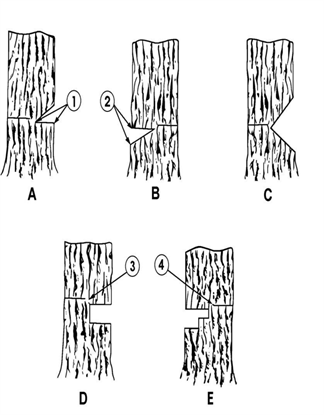PDFWAC 296-54-53910
Falling and bucking—Falling.
(1) Where felled trees are likely to roll and endanger workers, cutting must proceed from the bottom toward the top of the slope, and uphill from previously fell timber.
(2) A cutter must not be placed on a hillside immediately below another cutter or below other logging operations where there is probable danger.
(3) Cutters must be informed of the movement and location of other employees placed, passing, or approaching the vicinity of trees being fell.
(4) Before falling trees, cutters must:
(a) Ensure that all personnel are out of reach of the tree; and
(b) Ensure that all personnel are in the clear of logs, fallen trees, snags, or other trees that may be struck by the falling tree.
(5) While manual falling is in progress, all logging machines must be operated at least two lengths away from trees being manually fell.
EXCEPTION: | This provision does not apply to logging machines performing tree pulling operations or logging machines called upon by the cutter to ground hazard trees. All cutters must be notified of the logging machine's entrance into the area and all falling within two tree lengths of the logging machine must stop. |
(6) Trees must be fell into the open whenever conditions permit.
(7) Cutters must not fall into another strip; trade leaners on the line.
(8) Knocking over trees larger than six inches in diameter in lieu of cutting is prohibited, except as provided in WAC 296-54-53910(9).
(9) Domino falling of trees, including danger trees, is prohibited. Domino falling does not include the falling of a single danger tree by falling another single tree into it.
(10) Undercuts large enough to safely guide trees and eliminate the possibility of splitting must be used on all trees over six inches DBH.
For example: | A tree with no perceptible lean, having an undercut depth of one-fourth of the diameter of the tree and a face opening equal to one-fifth of the diameter of the tree would meet the requirement. |
(11) A cutter must place an adequate undercut and leave enough holding wood to ensure the tree will fall in the intended direction.
(12) The two cuts that form the undercut must not cross where they meet, except where a dutchman is required on either side of the cut.
(13) The undercut must not be made while other workers are in an area into which the tree could fall.
(14) A backcut must be made in each tree being fell.
(a) The backcut must be as level as possible;
(b) The backcut must leave enough hinge wood to hold the tree to the stump during most of its fall so that the hinge is able to guide the tree's fall in the intended direction; and
(c) The backcut must be above the level of the horizontal facecut to provide an adequate platform to prevent kickback.
EXCEPTION: | This requirement does not apply to open-faced falling where two angled facecuts are used instead of a horizontal facecut. |
(d) In tree-pulling operations the backcut may be at or below the undercut hinge point.
(15) Cutting holding wood instead of using wedges is prohibited. Swing cuts are prohibited except by an experienced person.
(16) Trees with face cuts and/or backcuts must not be left standing unless all the following conditions are met:
(a) The cutter clearly marks the tree;
(b) Discontinues work in the hazardous area;
(c) Notifies all workers who might be endangered; and
(d) Takes appropriate measures to ensure that the tree is safely fell before other work is undertaken in the hazardous area.
(17) Undercuts and backcuts must be made at a height above the highest ground level to enable the cutter to safely begin the cut, control the tree, and have freedom of movement for a quick escape from a falling tree.
(18) Lodged trees must be clearly marked and identified by a predetermined method and all persons in the area must be instructed not to pass or work within two tree lengths of the trees except to ground them.
Note: | See Figure No. 2, for illustrations of undercuts. |
 |
FIGURE 2: UNDERCUTS
(A) | Conventional undercut. Can be made with parallel saw cut and axe diagonal cut or both cuts with the saw. Generally used on trees of small diameter. |
(B) | Humboldt undercut. Leaves square-end log. Same as (A), except that waste is put on the stump. |
(C) | Open face undercut. Both cuts are made with the saw. The top and bottom face cuts generally form a 90 degree angle when completed. Works best on small diameter trees. |
(D) | Two parallel cuts with the saw. The material between the cuts is chopped out with an axe-adz (pulaski) combination. Used on trees over 30 inches in diameter. |
(E) | Three parallel cuts with the saw, leaving a step. Same in principle as (C). Used on trees of very large diameters. |
Item | ||
1 | Undercut depth | |
2 | Undercut height | |
3 | Holding wood | |
4 | Backcut | |